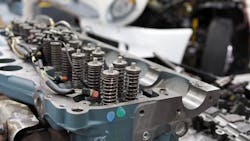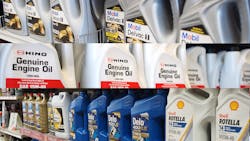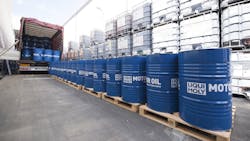There are many costs associated with operating a heavy truck, but engine oil is barely a comparative blip—the American Trucking Associations estimates it's about $0.0043 of every dollar spent. On average, oil for a truck might cost about $250 a year, notes Mark Betner, heavy duty lubricants manager at Citgo Lubricants. Truck drivers, meanwhile, spend an average of $600 each year on coffee.
"Just compare that to the cost of the life-blood of the diesel engine," he quips, putting things in perspective.
Take a very basic example of a switch to a lower-viscosity oil vs. the 15W-40 commonly in fleet use. Say a Class 8 on-highway tractor gets 7 mpg and does 100,000 miles a year; it'll take about 14,000 gal. of fuel to cover that distance. At $3.00/gal. for a cost of diesel, that's about $42,000 in annual fuel spend.
Ignoring any gains from better component protection and extended drain intervals, a lower-viscosity 10W-30 oil could provide a conservative 1% gain in fuel economy, Betner contends. That would save a little over $428 in fuel costs for the truck. Across a 50-truck fleet, that's over $21,000.
If those 50 trucks' oil is changed three times a year—again a conservative estimate, since they're covering 100,000 miles apiece and drain intervals with the latest oils are well beyond 33,000 miles—the trucks would need some 1,500 gal. of oil.
The estimated cost for that amount of oil is about $15,000, meaning the savings that could be available from a switch to lower-viscosity oil could pay for all the oil the fleet needs for 17 months, or perhaps longer in real life if greater fuel efficiencies are achieved.
Additives could be differentiator
Fleet equipment replacement cycles can take years, and that's part of what is holding back adoption of the latest engine oils. Older engines in the fleet may not be able to use low-viscosity oil, for example, and fleets like to choose a single oil they can use for all their equipment, simplifying purchasing and maintenance and minimizing costs.
But fleets should consider oil no different than a very specific spare part.
So advises Peter Szarafinski, head of international media relations for Germany-based oil and related products maker Liqui Moly. "It's a complicated situation for a fleet owner, especially if you have a very heterogenous fleet with lots of different vehicles," he says.
That's why it's important for fleets to have a conversation with their oil supplier to discuss their specific needs. Liqui Moly works to recommend oils "that are able to cover numerous specifications instead of providing a different oil for each and every specification," Szarafinski says—and that shouldn't be guesswork or a "one size fits all" approach.
"Oil truly is a liquid 'spare part' which needs to fit precisely to a certain engine," he tells Fleet Owner. "Using the wrong oil is like installing the wrong spare part. The issue is that you can pour just about any fluid in the engine and not see it isn't the right one; but if you installed the wrong brake disk, for example, it's usually very obvious if it's not right."
If you take engine oils that appear otherwise equal with the same viscosity ratings and specifications, an element to consider that could make an oil "the right one" for a fleet is the additives it contains. Those are special chemical compounds that can improve the performance of a base oil, explains Brian Humphrey, OEM Technical Liaison at Petro-Canada Lubricants.
It's one more complicating factor in the oil decision—and one more reason fleets need to research their choice of lubricants today more thoroughly. The additive package in an engine oil can make up some 10-20% of the oil's total volume.
"Additives are used to protect the hardware in engines," Humphrey says. "For example, specific additives include anti-oxidants, anti-wear or anti-foam [agents], detergents, and dispersants. Zinc dialkyldithiophosphate, often referred to as ZDDP, is a chemical that is used more commonly and offers both oxidation control and wear protection."
It's all part of how these new, lower-viscosity oils deliver lower friction and resistance in the engine, maintain component protection, and resist breakdown and oxidation (thickening) under stressful high-heat conditions. Each oil producer formulates its own "secret sauce" in additives packages.
"For low viscosity oils, sufficient anti-wear compounds or other forms of chemical surface protection must be included," Humphrey says. "Low-viscosity oils deliver benefits for fuel economy, but without the correct additives, they may not separate engine surfaces from rubbing, which results in wear."
He describes the additive chemicals as vital to the oil's performance—but cautions against adding more. More probably isn't better in this case.
"The balance of the [additive] formulation is crucial," Humphrey emphasizes, and additives "may not be fit for purpose on their own but can offer benefits when used in a properly formulated lubricant."
He advises against dabbling and experimenting with additives. "Due to this careful balancing requirement, adding supplemental additives to your oil is greatly discouraged, as there may be significant detrimental side effects," he says.
About the Author
Aaron Marsh
Aaron Marsh is a former senior editor of FleetOwner, who wrote for the publication from 2015 to 2019.


